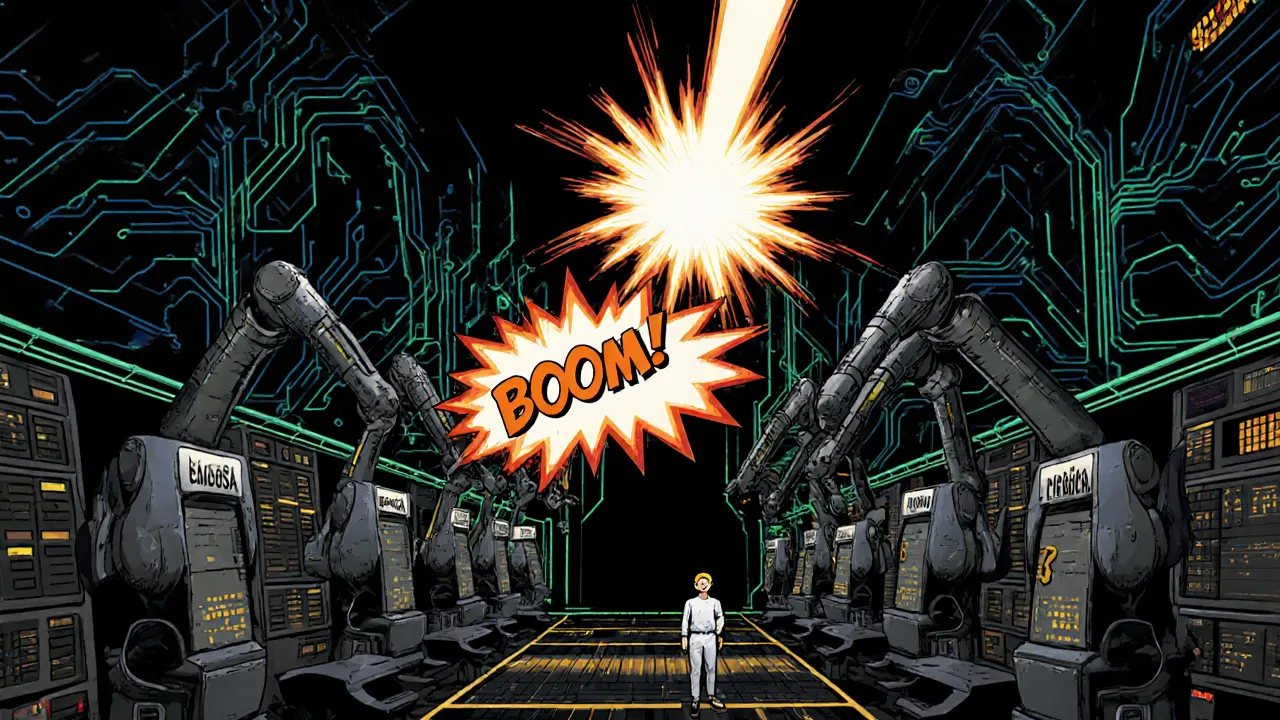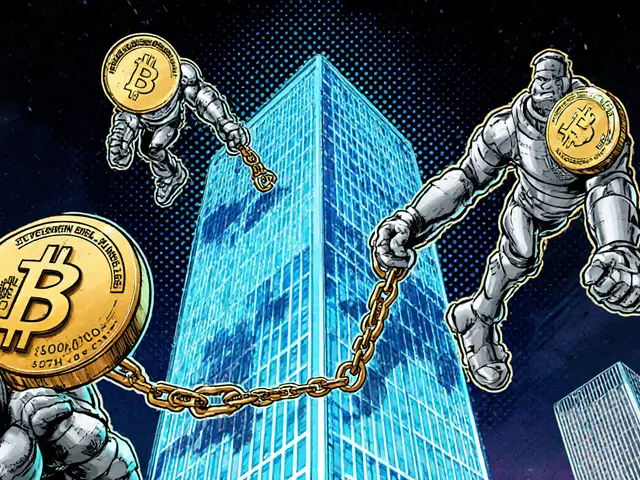Bitcoin Transaction Fee Calculator
Calculate Your Savings
Transaction Savings Breakdown
That's bytes saved annually - enough to store Bitcoin transactions!
Before Taproot activated in November 2021, every Bitcoin transaction used the same signature system: ECDSA. It worked. It was secure. But it was clunky. If you wanted to send Bitcoin with two people signing off - say, a joint wallet or a business account - you had to reveal that multiple keys were involved. The blockchain saw it all: the number of signatures, the public keys, the structure. It was like walking into a bank with a stack of IDs instead of one smart card. Then Schnorr signatures arrived. Not as a replacement, but as an upgrade that quietly fixed decades-old problems.
Why ECDSA Was the Default for 12 Years
ECDSA, or Elliptic Curve Digital Signature Algorithm, became Bitcoin’s signature standard because it was available, proven, and patent-free in 2009. It’s based on the same math as other elliptic curve systems: hard to reverse, easy to verify. But its design has quirks. Each signature is 70-72 bytes long, and the public key takes 33 bytes. That’s not huge, but when you’re processing millions of transactions, every byte adds up.ECDSA also has a hidden flaw: malleability. If someone intercepts a valid transaction, they can tweak the signature slightly - without knowing the private key - and create a new, still-valid signature for the same transaction. This broke some early Bitcoin applications, forcing developers to build workarounds like transaction ID hashing and witness malleability fixes. It wasn’t a security flaw in the private key, but it created chaos in systems relying on predictable transaction IDs.
Another issue? Multisignature. If you needed 2-of-3 signatures, Bitcoin used CHECKMULTISIG. That meant the blockchain had to store all three public keys and all signatures. A 2-of-3 multisig could balloon to over 500 bytes. It was inefficient, expensive, and gave away your wallet structure. Privacy? Gone. Anyone watching the chain could tell you were using a multisig wallet - and often, how many people were involved.
Schnorr Signatures: Simpler, Smaller, Stronger
Claus-Peter Schnorr invented his signature scheme in the 1980s. But for decades, it sat unused because of patents. Bitcoin couldn’t use it. So developers built ECDSA instead. When the patents expired, Bitcoin developers finally had a clean path forward. BIP 340, part of the Taproot upgrade, brought Schnorr signatures into Bitcoin’s core.Schnorr signatures are 64 bytes - 6 to 8 bytes smaller than ECDSA. Public keys? Just 32 bytes. That’s a 3% reduction per transaction. Sounds small? Multiply that by 500,000 daily transactions, and you’re saving over 3GB of blockchain space per year. That’s not just efficiency - it’s lower fees and faster syncing.
But the real win is linearity. Schnorr signatures are mathematically linear. That means you can add signatures together. Two signatures? Add them. Three? Add them. The result is one single signature that proves all parties signed. This is called key aggregation. And it’s revolutionary.
Key Aggregation: The Hidden Superpower
With Schnorr, a 2-of-2 wallet doesn’t look like a multisig. It looks like a normal single-key transaction. The blockchain sees one public key and one signature. No one can tell it was a joint wallet unless you tell them. That’s not just privacy - it’s fungibility. All Bitcoin looks the same. No more “this coin came from a multisig wallet” stigma.Companies using multisig for custody - like exchanges or institutional wallets - now save space and reduce costs. A 3-of-5 corporate wallet used to take up 800+ bytes. Now? It’s 64 bytes. Same as a personal wallet. That’s a 90% reduction in on-chain footprint. And since the signature is aggregated, batch verification gets faster. Nodes can verify dozens of Schnorr signatures at once, in a single operation. ECDSA can’t do that efficiently.
There’s also no malleability. A Schnorr signature is either valid or invalid. No tweaking. No tricks. That makes Lightning Network channels and other second-layer protocols more reliable. No more broken HTLCs because someone malleated a signature.

Security: More Provable, Fewer Edge Cases
Both ECDSA and Schnorr rely on the same security foundation: the discrete logarithm problem. Break that, and both are broken. But Schnorr’s security proof is cleaner. It’s easier to mathematically prove that Schnorr signatures can’t be forged under standard assumptions. ECDSA’s proof is messier, with more assumptions and edge cases.ECDSA requires careful nonce generation. If you reuse a nonce - even once - your private key is exposed. That’s how the PS3 was hacked in 2010. Schnorr has the same risk. But because Schnorr signatures are linear, you can use deterministic nonces without complex workarounds. Developers report fewer bugs when implementing Schnorr. The code is simpler. Fewer lines. Fewer places for mistakes.
ECDSA also needs key prefixing in some contexts to prevent attacks. Schnorr doesn’t. That’s one less thing for wallet developers to mess up. And because Schnorr signatures are non-malleable, you don’t need extra layers like SegWit’s witness malleability fix. Taproot didn’t just add Schnorr - it removed the need for half the patches Bitcoin had accumulated.
Performance: Faster, Lighter, Scalable
Verification speed? Schnorr is about 15% faster than ECDSA. Not a game-changer for one transaction. But for a full node validating thousands per second? That’s hours saved per day. Memory usage is lower. Bandwidth is lighter. And batch verification? That’s where Schnorr shines.Imagine you’re a miner or a full node. You have 100 transactions to verify. With ECDSA, you verify each one separately - 100 separate operations. With Schnorr, you can combine all 100 signatures into one, and verify them in a single mathematical operation. That’s not just faster - it’s exponentially more efficient. The gain grows with volume. As Bitcoin scales, this becomes critical.
Lightning Network channels benefit too. Channel closures, which require signing transactions, are now smaller and faster. That means faster dispute resolution and lower costs for users. Even routing nodes benefit from smaller data packets.

Privacy: The Silent Revolution
This is the quietest, most important change. Before Taproot, multisig wallets were public records. If you used a hardware wallet with two devices, or a company wallet with three signers, the blockchain told everyone. You were flagged. Your wallet type was visible. Your spending patterns were predictable.Schnorr changes that. A 3-of-5 corporate wallet? Looks like a single-key wallet. A joint family wallet? Just another regular Bitcoin address. Blockchain analysts can’t tell the difference. That’s not just privacy - it’s economic freedom. No more discrimination against multisig users. No more “this coin is tainted because it came from a cold wallet.”
Even more powerful: threshold signatures. With Schnorr, you can set up a 2-of-3 system where any two out of three parties can sign - without revealing who signed. That’s useful for enterprise custody, decentralized finance, and even personal inheritance setups. ECDSA can’t do this cleanly. Schnorr can.
Adoption: The Slow Shift
ECDSA isn’t going away. Old wallets still use it. Old transactions still exist. But new wallets? Most major ones - like BlueWallet, Sparrow, and Ledger Live - now support Schnorr signatures. Taproot adoption is growing. Over 40% of new Bitcoin transactions as of late 2025 use Taproot-enabled addresses. That’s up from 15% in early 2023.Exchanges are slowly moving. Coinbase, Kraken, and Bitfinex now allow users to send and receive Taproot transactions. Mining pools recognize them. Block explorers display them. The ecosystem is catching up. The next wave? Wallets that default to Schnorr. That’s already happening in open-source projects. Soon, it’ll be the norm.
What’s Next for Schnorr?
Researchers are already exploring signature aggregation across multiple transactions - not just within one transaction. Imagine a batch of 50 Lightning channel updates, all signed with one aggregated Schnorr signature. That could cut blockchain load by 90% for channel management. It’s not live yet, but the math works.Other blockchains are watching. Litecoin, Bitcoin Cash, and even Ethereum’s Layer 2 solutions are testing Schnorr. The benefits are too clear to ignore: smaller, faster, private, scalable. Bitcoin led the way. Now others are following.
ECDSA did its job. But Schnorr signatures are what Bitcoin needed to grow up. Not a revolution. An evolution. Cleaner. Smarter. More private. And for users? Just a smoother experience - without even knowing it.
Are Schnorr signatures more secure than ECDSA?
Yes, in practical terms. Both rely on the same underlying math (elliptic curve cryptography), so their theoretical security is equal. But Schnorr signatures have simpler, more robust security proofs. They’re inherently non-malleable, which ECDSA isn’t. They also avoid complex implementation requirements like key prefixing and nonce randomization edge cases that have led to real-world ECDSA exploits. For developers, Schnorr is less error-prone.
Do Schnorr signatures reduce Bitcoin transaction fees?
Yes, directly and indirectly. A single Schnorr signature is 64 bytes - 6-8 bytes smaller than ECDSA. That’s less data, lower fees. But the bigger savings come from multisig and batch verification. A 3-of-5 multisig that used to cost 800+ bytes now costs 64 bytes. That’s a 90% drop in fee cost. And with batch verification, nodes process transactions faster, reducing congestion and indirectly lowering fees across the network.
Can I still use ECDSA after Taproot?
Yes. Taproot didn’t remove ECDSA. It added Schnorr as an option. Old addresses (P2PKH and P2SH) still work. But new wallets are moving to Taproot (P2TR) addresses by default. If you’re using a modern wallet, you’re likely already using Schnorr without realizing it. Your old transactions stay valid - they just don’t get the benefits.
Why didn’t Bitcoin use Schnorr signatures from the start?
Because they were patented. Claus-Peter Schnorr filed patents in the 1980s and 1990s that blocked anyone from using his signature scheme without licensing. Bitcoin launched in 2009, and the patents were still active. Developers chose ECDSA because it was patent-free and available. Once the patents expired around 2010-2012, Bitcoin developers began working on BIP 340. It took another decade to get consensus and activate Taproot.
Do Schnorr signatures make Bitcoin more private?
Yes, dramatically. Before Schnorr, multisig wallets were obvious on the blockchain. Now, a 2-of-3 wallet looks exactly like a single-key wallet. No one can tell how many people signed unless you tell them. This improves fungibility and prevents wallet profiling. Even Lightning Network channels benefit - channel setups and closures are now indistinguishable from regular payments. Privacy isn’t optional anymore - it’s built in.



